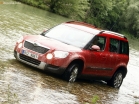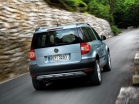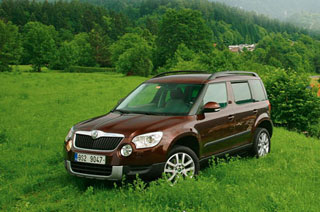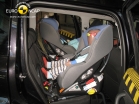Skoda Yeti test drive since 2009 -
Children against Yeti
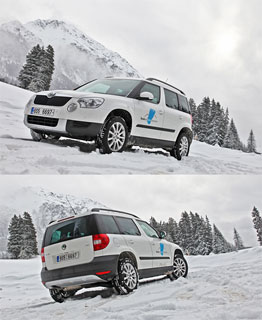 While the time and territory of winter has not ended, we decided on the experiment to bring our nose to the nose of Skoda Yeti and Octavia Scout. Why them? Everything is simple. These are two alternative options for the embodiment of off-road and light ideology within one brand. Which one is preferable? Let's try to figure it out.
While the time and territory of winter has not ended, we decided on the experiment to bring our nose to the nose of Skoda Yeti and Octavia Scout. Why them? Everything is simple. These are two alternative options for the embodiment of off-road and light ideology within one brand. Which one is preferable? Let's try to figure it out. Yeti with a materiel almost completely repeats his brother in the Volkswagen Tiguan concern. The power structure of the body is identical to Tiguanovskaya, the front and rear suspension from the Passat, although the Yeti body is 45 mm shorter. Yeti designers boldly beat racks and lighting equipment. They provided a crossover with more practical unpainted bumpers and other rapids. The Czechs managed to create an amazingly paradoxical image: Yeti is simultaneously calm and expressive, youth and conservative. The crossover is fresh and traditional at once ...
Engines with which yeti are supplied to Russia, two 1.2 TSI (105 hp, 175 nm) and 1.8 TSI (152 hp, 250 nm). The first motor can be chosen both with a mechanical five -speed gearbox, and with a seven -speed automatic DSG. But there is one but, cars with a 1.2-liter engine only front-wheel drive. 1.8 TSI is all -wheel drive, and it is so far only with a manual gearbox. The pre -sequent DSG on the Yeti with powerful motors made her debut only now during the Geneva Motor Show. In Europe, such machines will be available in the very near future, and we will appear closer to winter. Diesel versions with a capacity of 110, 140 and 170 hp (they develop 250, 320 and 350 nm, respectively) In Russia, they are not expected for us to be too expensive. It’s a pity that the motors are excellent and they are not deprived of traction, and economy is good.
Octavia scout derivative of all -wheel drive Octavia Combi. From the road version, Scout is characterized by increased road clearance (179 mm versus 140 mm) and more protected from mechanical influences by the body. Bumpers with plastic skis are not afraid of blows and gross mechanical influences. The thresholds and arches of the wheels are protected by unpainted plastic overlays. The engine received enhanced protection, and the bottom is almost over the entire area by anti -gravian shields. The basis of the Octa Volkswagen Platform PQ35, on which the fifth golf is built. Hence the family habits.
Our car is offered with a single power unit a 152-horsepower turbocharged motor (it is also put on Yeti) works with six-speed mechanics. In Europe, an alternative to a 140-horsepower diesel is offered a gasoline engine, which develops 320 N ∙ m, it is also available only with mechanical transmission.
Gasoline 1.8 TSI deserves only flattering words. No wonder this motor in Russia has become the main one for both cars. TSI is assertively dragging from 2000 rpm. Yeti and Scout, after pressing the gas pedal, simply lose weight and rush forward. At the same time, an excess of traction, even on slippery coatings, is not felt. It is easy and pleasant to control the acceleration, since the range of maximum torque of 250 Newton meters lies in the range of 1,500-3500 rpm.
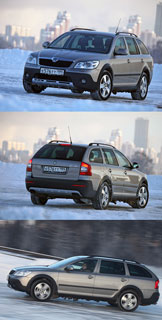 It’s a pleasure to sit behind the wheel. Reclining landing, the widest range of adjustments at the workplace will conveniently arrange drivers of any build. For one sitting in the station wagon without straining you can overcome many hundreds of kilometers. The driver in Yeti sits more vertically than in Octavia, landing one on one as in Tiguan and Golf Plus. High here is less convenient. The range of departure by departure is insufficient, I always wanted to pull the steering wheel a little on myself.
It’s a pleasure to sit behind the wheel. Reclining landing, the widest range of adjustments at the workplace will conveniently arrange drivers of any build. For one sitting in the station wagon without straining you can overcome many hundreds of kilometers. The driver in Yeti sits more vertically than in Octavia, landing one on one as in Tiguan and Golf Plus. High here is less convenient. The range of departure by departure is insufficient, I always wanted to pull the steering wheel a little on myself. Another ergonomic blunder steering wheel overlaps the upper segments of large scales of devices that migrated here with some changes from the superb. At the back in both cars, even basketball players will be shedding for themselves. The quality of finishing materials and execution in both machines at a height. According to transformations, the Bigfath salon is definitely the best among classmates. The Varioflex system allows you to modify the internal space as you like. The rear sofa is cut into three separate seats, all of them independently move forward-back and have adjustments to the back of the back. With such seats, a compromise between the placed passengers and the cargo transported is very easy to find. If all the seats are moved forward and put the backs as vertically as possible the luggage volume (along the lower window line) will increase from 322 to 510 liters. If you need to transport something long, but not too dimensional, you can simply put your backs on the pillows of the cargo compartment to 1580 liters.
It is also allowed to fold and fix each of the folded chairs vertically (they will stand close to the front seats). In the case when the maximum volume is needed, the rear row can be dismantled at all. Fortunately, the removal/installation operation is simple, and the mass of the seats themselves is small. Then the volume of the cargo compartment will increase to a record 1760 liters! If you know that there will be two passengers in the back row, you can add comfort to them on the long journey by removing the central section of the sofa and moving the extreme sections to the center. What's the point? All just sitting from behind will no longer touch the doors and racks with their shoulders and heads. Transformation of the Octavia salon is simpler. Here the rear folding sofa is cut in a ratio of 2: 3. The seats, of course, are not removable, but they can be heated. The volume of the trunk, which with a decomposed rear row is 605 liters (according to the window line), can be increased to 1655 liters.
We managed to travel several times on Yeti and all -wheel drive Octavia. The first acquaintance with a snowy man took place in Slovenia last spring. For the first time, we first tried all -wheel drive OKTU with the new Haldex coupling in Sweden at the beginning of last year. Now we drove cars on the Swiss Alps. Here is the whole spectrum of road difficulties: passes with many protracted winding lifts and descents, snow, ice, storms, periodic transitions through zero temperature, high -speed autobahns
Yeti behaves very mature on the asphalt. Even despite the relatively high center of gravity, he is almost not fired in corners, an adequate feedback force on the steering wheel. The suspension here is more energy-intensive and comfortable (diesel versions with heavy engines are less comfortable due to reinforced springs). SCUT is tougher, the microprofile of the roadway to the body is more distinct here. The station wagon is well. Parity for acoustic comfort. The dynamics (with a 1.8 TSI engine) is also identical, both have eight and a half seconds to hundreds, and the maximum speed is 200 km/h. The 1.2-liter front-wheel drive of Yeti, of course, is slower. From a place of 100 km/h, he gains in 11.8 seconds (with an automatic DSG 12), a maximum speed of 175 km/h. Such a yeti is much more economical, in mixed mode for 100 kilometers of path, it requires 6.4 liters of gasoline, a 1.8-liter engine eats 8.0 liters. Octavia in a mixed cycle requires 7.8 liters due to the best aerodynamics.
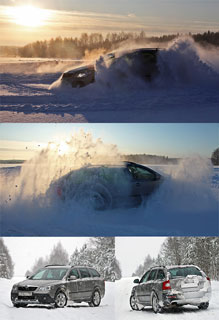
Plowing a 50-centimeter snow virgin land even scout is not difficult
On the icy and snowy passes, thanks to the connected complete drive you feel much more confident. Where monopying cars have long demanded an anti -scum chains, our all -wheel drivers even continue to go and go on non -navigable rubber. But on the Swiss roads with the ideal canvas of the entire charms of an off -road package you can’t feel. Actually, therefore, we decided to conduct an additional off-road test in Russia, having arranged a 700-kilometer marathon in the Moscow and Kaluga regions. The uncleaned Russian sneaks, which we reached the village of Nikola-Lenivvets, again confirmed the advantages of all-wheel drive. By the way, in Nicola we spent the whole day and did not regret the droplets.
Hello field! Yeti has a clearance of 180 mm, a scout sits only 1 mm lower. But Yeti outside the roads feels tangibly more confident thanks to the best geometric cross -country ability. With an equal base (2578 mm), 361 mm is shorter than Octavia (4223 versus 4584 mm), it has smaller overhangs, and the corners of the congress/entry are larger. Although the deepest tractor track unnoticed under the snow, across which I sat on Octavia, Yeti would still not overcome it. To get our station wagon from the frozen trap, it took a jack and tractor, the role of which was played by the passing by Defender
Yeti off -road movement is able to simplify markedly. The crossover has a system for the help of descent from the mountain, which works both when moving forward and when moving back. In order to activate it, you need to enable the OFF Road mode (in this case, the feedback on the gas pedal is more smooth), stop on the descent and switch to the neutral. To move, you need to release the brake. The system allows you to adjust the descent speed. I pressed the gas went faster, pressed the brake slower. The given speed supports ABS (tunes on the most effective braking on slippery/loose coating), selectively branding the necessary wheels and carefully tucked the car on the selected trajectory. The system is useful on both the slope that has deified after the rain and on the icy spiral of multi -story parking lots
What resume? Octavia Scout is more suitable for highways, it has the best aerodynamics and less fuel consumption, as well as a denser suspension, which is less preferable on broken roads. A large family in scout will be better off the trunk is more voluminous. Yeti on the asphalt is no worse, but he overcomes light off -road more confidently due to the best geometric cross and the presence of auxiliary electronics. At the same time, he has a less convenient workplace for high drivers and less (with laid up chairs) trunk. Although Yeti is more friendly to passengers, the rear removable seats have a number of adjustments. If the seats are dismantled, the maximum volume of the cargo compartment will be even more than that of scout.
In terms of safety, Yeti is preferable. According to the testing methodology, Euro NCap Yeti received a five -star rating, Octavia is content with four stars. Both cars around the perimeter can have six airbags. In Yeti, a pair of side pillows (as on Tiguan) intended for the rear passengers is available to order. The disconnected stabilization system works both for skidding and demolition on both cars.
An all -wheel drive Yeti begins at 899,000 rubles. Octavia Scout will cost at least 979,000. These scouts 80 thousand include lateral airbags along with curtains, rear parking sensors, a two-zone climate (yeti air conditioning), on-board computer, light and rain sensors, rear electric windows, audio system with CD/MP3-chainer , alloy wheels, fog, cruise control. The listed benefits of civilization in Yeti can be obtained by stopping at Experience for 1,019,000 rubles, and not all, for some things that are already in the basic performance of Octavia, must be paid extra.
Vitaly Kabyshev
Photo by the author
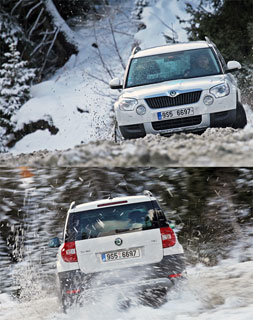
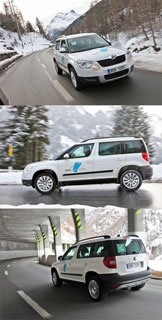
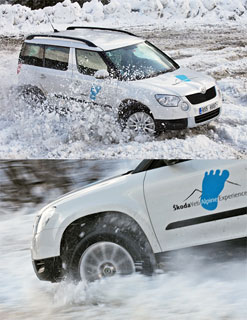
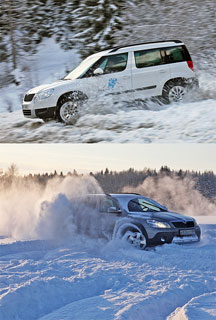
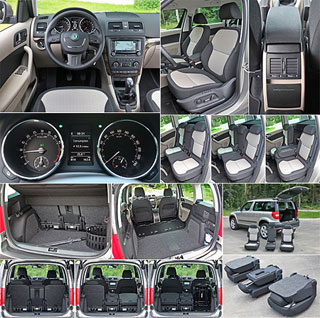
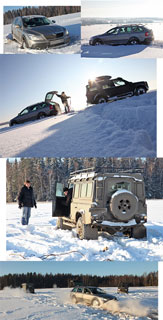
Source: Auto.mail.ru
Video test drives Skoda Yeti since 2009
Video crash tests Skoda Yeti since 2009
Skoda Yeti test drive since 2009
Skoda Yeti Crash Test since 2009
Krassh Test: Detailed Information92%
Driver and passengers
46%
Pedestrians
78%
Children-passengers
71%
Active security system
Skoda Yeti malfunctions since 2009
Skoda Yeti malfunctions: Detailed information| Yeti since 2009 | |
|---|---|
| Engine |  |
| Transmission | |
| Control system and suspension |  |
| Brake system |  |
| Air heating and air conditioning |  |
| Launch and charging system |  |
| Electric components and so on |  |
| Corrosion body stability |  |



